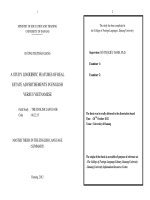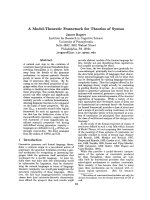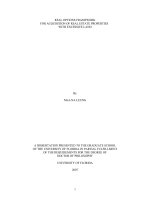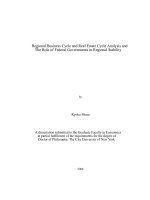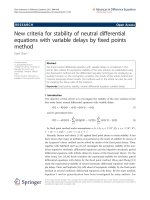real options framework for acquisition of real estate properties with excessive land
Bạn đang xem bản rút gọn của tài liệu. Xem và tải ngay bản đầy đủ của tài liệu tại đây (883.89 KB, 123 trang )
1
REAL OPTIONS FRAMEWORK
FOR ACQUISITION OF REAL ESTATE PROPERTIES
WITH EXCESSIVE LAND
By
NGA-NA LEUNG
A DISSERTATION PRESENTED TO THE GRADUATE SCHOOL
OF THE UNIVERSITY OF FLORIDA IN PARTIAL FULFILLMENT
OF THE REQUIREMENTS FOR THE DEGREE OF
DOCTOR OF PHILOSOPHY
UNIVERSITY OF FLORIDA
2007
UMI Number: 3281555
3281555
2007
UMI Microform
Copyright
All rights reserved. This microform edition is protected against
unauthorized copying under Title 17, United States Code.
ProQuest Information and Learning Company
300 North Zeeb Road
P.O. Box 1346
Ann Arbor, MI 48106-1346
by ProQuest Information and Learning Company.
2
© 2007 Nga-Na Leung
3
To my husband, Lezhou Zhan, and my family,
Lau Leung, Sau-Pik Fung, Shing-Pen Leung, and Shing-Chiu Leung
4
ACKNOWLEDGMENTS
I would never be able to adequately thank Dr. R. Raymond Issa, my chair, for making
room for me to develop my research question, as well as helping me to choose the direction of
my life. I want to thank him not only for his tremendous guidance, considerable patience and
encouragement throughout my study, but also for his endless trust, respect, and understanding,
which has forged me into a better person, not only with intelligence, but with responsibility.
I am especially grateful to Dr. Wayne Archer, Dr. Ian Flood, Dr. Kevin Grosskopf and Dr.
Robert Cox, for their discussions, suggestions, and encouragement during the development of
this dissertation. It is a great honor to have them serve on my committee. I am in debt to Dottie
Beaupied for her tremendous helps, especially during the dissertation submission process.
I would also like to acknowledge the generous financial support from the University of
Florida and the UF Alumni Association, from which I will carry the Gator spirit for the rest of
my life.
I am in debt to Andrew Weiss, who has been the best mentor in my real estate profession,
and has also provided generous help in data collection for this study. Besides him, I was working
with an amazing team in Parmenter Realty Partners, and especially thankful to Darryl Parmenter,
Ed Miller, and Mark Reese, for their insightful advice on career choices and their tremendous
helps at work.
Special thanks go to all my folks when I was in UF, whose love and friendship became
part of the happiest memory of my life. I am especially grateful to Yujiao Qiao, Yang Zhu,
Hongyan Du, Dongluo Chen, Jon Anderson, and Hazar Dib, whose encouragements have me to
complete this dissertation in time.
5
I want to extend a special word of thanks to all my mentors in the past, Dongshi Xu,
Fuchang Lai, Shensheng Xu, Shouqing Wang, and David Ling, whose wisdom and insight have
profound influence on my character and personality.
This work is dedicated to Lezhou Zhan, my husband and best friend, for his company
throughout my life in good days and in bad ones; and to my beloved family: Lau Leung, my
father; Sau Pik Fung, my mother; Shing-Chiu Leung, my little brother; and Shing-Pen Leung,
my deceased brother. The honor goes to them, for their thirty years of nurture with endless love
and care.
6
TABLE OF CONTENTS
page
ACKNOWLEDGMENTS 4
LIST OF TABLES 9
LIST OF FIGURES 10
ABSTRACT 13
1 INTRODUCTION 15
Background 15
Statement of Research Problem 16
Goal and Objectives 18
Research Scope 18
Significance and Contributions 19
Organization of Dissertation 19
2 REVIEW OF REAL ESTATE VALUATION 20
Current Practice 20
Distinguishing Acquisition and Development 20
Typical Acquisition Valuation Process 21
Current Real Option Approach and Limitations 24
Decision Tree Analysis and Limitations 25
Real Options in Real Estate 25
Theoretical Models 25
Empirical Testing 31
The RERO Approaches 31
Summary 32
3 LITERATURE REVIEW 33
Traditional Discounted Cash Flow Approaches 33
Capital Budgeting Theory 34
Market Risk and Private Risk 34
Capital Asset Pricing Model 34
Discount Rate 35
Option Pricing Theory 36
Definition and Type of Options 36
Black-Sholes Model and Stochastic Partial Differential Equations 38
Lattices 42
Monte Carlo Simulation 45
Real Options Analysis Approaches 46
Practical Real Options Model in Real Estate 50
7
Decision Tree Analysis 53
Summary 54
4 METHODOLOGY 55
RERO Modeling Procedures 55
Problem Framing 55
Approach Selection 57
Risk Drivers Identification and Estimation 57
Base Case Modeling 57
Option Modeling 58
Sensitivity Analyses 58
RERO Modeling Approaches 58
The Combined Approach 59
The Separated Approach 61
RERO Modeling Techniques 63
Rational for Using Binomial Lattices 63
Monte Carlo Simulation 64
Replicating Portfolio 64
Binomial Lattice with Jump Process 66
Investment with Private Uncertainty 68
Summary 71
5 THE COMBINED APPROACH 72
Case Description 72
Building Valuation 73
Problem Framing 73
Approach Selection 74
Base case NPV calculation 74
Risk Drivers Modeling 78
Option Modeling 85
Sensitivity Analyses 91
Summary 95
6 THE SEPARATED APPROACH 96
Case Description 96
Land Valuation 97
Problem Framing 97
Approach Selection 98
Risk Drivers Identification and Estimation 98
Base Case Modeling 103
Option Modeling 103
Sensitivity Analyses 108
Summary 114
8
7 CONCLUSIONS AND RECOMMENDATIONS 115
Conclusions 115
Recommendations for Future Research 116
LIST OF REFERENCES 118
BIOGRAPHICAL SKETCH 122
9
LIST OF TABLES
Table page
2-1 Comparison of Research Subjects, Model Variants, Contributions and Limitations. 28
3-1 Type of Real Options 47
3-2 Financial Options versus Real Options 47
3-3 Correspondence between Financial and Real Options 51
5-1 Major Assumptions for Argus. 75
5-2 Correlation Between Random Variables. 87
5-3 Statistical Summary of Monte Carlo Simulation Result 87
5-4 Event Tree Assumptions 88
5-5 Summary of Variable Effect on Option Value. 91
6-1 Development Assumptions. 97
6-2 Probabilities of Jump Diffusion and Binomial Processes 107
10
LIST OF FIGURES
Figure page
2-1 Real estate phases and major factors to consider 22
2-2 Current acquisition valuation process 23
2-3 Real Options approaches for land valuation. 27
3-1 Payoff of call option and put option. 37
3-2 Call option payoff example 37
3-3 Call premium vs. security price. 41
3-4 Stock and option price in a one-step binomial tree 42
3-5 Stock and option prices in general two-step tree. 44
3-6 Monte Carlo simulation output. 45
4-1 Critical steps in RERO analysis 56
4-2 Two-step binomial lattice with different dividend yields 66
4-3 Binomial lattice with jump process 68
4-4 Quadranomial lattice 70
4-5 Decision analysis. 70
5-1 211 Perimeter site plan 73
5-2 Base case NPV calculation. 76
5-3 Spreadsheet model for Monte Carlo simulation. 79
5-4 Historical market and subject property rental rates. 80
5-5 Returns correlation between market and subject property 80
5-6 Normal distribution fit for historical returns on rental 82
5-7 Historical market and subject property occupancy rates. 83
5-8 Occupancy changes correlation between the local real estate market and the subject
property
84
11
5-9 Normal distribution fit for historical occupancy rates. 84
5-10 Snap shot of Monte Carlo simulation assumptions 86
5-11 Monte Carlo Simulation Result of Forecasting Variable z. 86
5-12 Normal distribution fit of forecasting variable z 87
5-13 Event tree present value without flexibility 89
5-14 Present value with flexibility. 90
5-15 Option value in relation with present value. 92
5-16 Option value in relation with replacement cost. 92
5-17 Option value in relation with present value and volatility 93
5-18 Option value in relation with volatility and discount rate 94
5-19 Option value in relation with replacement cost and volatility. 94
5-20 Option value in relation with present value and replacement cost. 95
6-1 Historical market average rental rates and return volatility 99
6-2 Normal distribution fit for historical market rental returns. 99
6-3 Gross rental rate movement and probabilities. 100
6-4 Building value movement and probabilities. 101
6-5 Historical construction cost for high-rise office building. 102
6-6 Construction cost change rate and inflation rate 102
6-7 Development cost assumptions 103
6-8 Payoff and probabilities without flexibility. 104
6-9 Payoff matrices for project values without flexibility. 105
6-10 Decision payoff and probabilities with flexibility. 106
6-11 Payoff matrices of project value with flexibility. 107
6-12 Present value in relation with rental rate and occupancy rate 109
6-13 Option value in relation with rental rate and occupancy rate. 110
12
6-14 Present value in relation with rental rate and development cost 110
6-15 Option value in relation with rental rate and development cost. 111
6-16 Present value in relation with rental rate and Cap rate. 112
6-17 Option value in relation with rental rate and Cap rate 112
6-18 Option value in relation with rental rate and Cap rate in 3D. 113
6-19 Present value in relation with volatility and Cap rate 113
6-20 Option value in relation with volatility and Cap rate 114
13
Abstract of Dissertation Presented to the Graduate School
of the University of Florida in Partial Fulfillment of the
Requirements for the Degree of Doctor of Philosophy
REAL OPTIONS FRAMEWORK
FOR ACQUISITION OF REAL ESTATE PROPERTIES
WITH EXCESSIVE LAND
BY
Nga-Na Leung
August 2007
Chair: Raymond Issa
Major: Design, Construction, and Planning
Our study touches a field that few researchers explore: the valuation model for acquisition
of a property with excessive land that can be potentially converted into a new development.
Traditional valuation focuses mainly on the building improvement. With the drastic
capitalization rate compression, however, it becomes critical to identify and explore any hidden
value in an acquisition. One of such challenges is valuing a large partially vacant parcel that can
be potentially converted into a new development.
Valuation of these parcels is not straightforward. Traditional discounted cash flow
approach (DCF) cannot take into account the uncertainty and development flexibility.
Alternative approaches are real options analysis (ROA) and decision tree analysis (DTA).
However, the “twin asset” assumption required by the ROA methodology is often violated,
especially for assets with private risk and rare events. The use of the same discount rate
throughout valuation period in the DTA approach, regardless of changing risk characteristics
upon the execution of decision making, allows for arbitrage opportunity.
Our proposed real estate with real options (RERO) model is a framework that combines
DCF, ROA and DTA analyses to specifically value real estate acquisition with excessive infill
14
land. This methodology not only overcomes the shortcoming of current DCF method, but also is
superior to the pure ROA or DTA analysis. Focusing on applicability in practice, this framework
is developed intuitively with simple mathematics whenever possible. The study also explores a
few unconventional real options cases, all of which could have been very complicated if modeled
using the partial differential equations common in the academy, including (1) jump diffusion
process that does not go back to normal diffusion, (2) risk drivers that do not follow the
multiplicative stochastic movement, (3) private risk that has no market equivalent and hence
violating the non-arbitrage option pricing assumption. All of these are implemented simply
through binomial lattice with Monte Carlo simulation or DTA.
The RERO framework is applied to a real case in Atlanta. Valuation has two parts: (1) the
improvement is modeled using a combined approach with Monte Carlo simulation, and (2) the
incremental value using a separated decision approach with binomial lattice technique. The
valuation result is very close to the actual closing price.
Three conclusions can be drawn from this study: (1) acquisition and development has
different characteristics and deserve different kinds of attention; (2) consideration of managerial
flexibility can change investment decisions; and (3) many unconventional real option valuation
problems can be resolved by binomial lattice and Monte Carlo simulations.
The novelty of this study is the research subject: property acquisition with excessive land.
From the methodology standing point, the RERO framework is developed with ease of
applicability in mind. It bridges the gap between research and practice for real options
applications in the real estate industry.
15
CHAPTER 1
INTRODUCTION
Background
Our study touches a field that very few academicians have explored: the valuation model
for acquisition of a property with excessive land that can potentially be converted into a new
development.
The three major schemes in real estate property investment are acquisition, development,
and operation. Acquisition is the ownership transaction of land and improvement; development
is the process of adding improvement to the land; and operation is the daily management of the
property.
A majority of researchers focus on development, perhaps due to its high uncertainty.
Acquisition, on the other hand, has been ignored to a certain extent considering its volume and
size of transactions. Acquisition has been regarded as relatively low risk, since it is an
investment on a touchable real property, which has historical operating track records, and
numerous location attributes that last for decades and centuries.
In recent years, however, real estate capitalization rates (defined by dividing the
acquisition cost by annual net operating income) have compressed dramatically, meaning real
estate is far more expensive to acquire than ever before. It becomes critical to identify and
explore any hidden value in an acquisition target in order to be competitive.
The proposed acquisition model has two parts: firstly, valuation of the income producing
part of the property, mainly the improvement; secondly, the incremental value, mainly the
excessive land that, depending on the circumstance of where the property is located, may have
no value or substantial upside value.
16
The proposed real estate with real options (RERO) model is a framework that combines
real options and decision tree analyses. This methodology not only overcomes the shortcoming
of the current discounted cash flow method, but also is superior to the existing real options or
decision tree analysis. Focusing on applicability in practice, this framework is developed
intuitively using simple mathematics whenever possible. The improvement is modeled using a
consolidated approach with Monte Carlo simulation, and the incremental value using a separated
decision approach with binomial lattice technique.
Statement of Research Problem
The fundamental value of real estate is the income producing capability of the property,
which depends on many factors such as the amount of rental income to collect, the operating and
financing expenses, the level of risk of the cash flow, the appreciation or depreciation of property
value, and the performance of alternative investment instruments in the financial market.
Acquisition valuation is the projection of future earning capability of a property related to other
alternative investments. Traditional valuation mainly focuses on the building improvement.
With the drastic capitalization rate compression, however, it becomes critical to identify and
explore any hidden value in an acquisition. One such challenge is valuing a large partially
vacant parcel that can be potentially converted into a new development.
The attachment of excessive land to a property is not uncommon. Some developments
were initially planned in phases, but the later phases were never implemented due to economic
downturn or undesirable outcome of earlier phases. The land planned for later project phases
thus remains vacant for a long time. Some early developments were planned on large parcels to
insure sufficient space of surface parking. When the region becomes well developed and the
economy turns to be more favorable, the vacant land becomes valuable for dense urban infill.
17
Valuation of these parcels, however, is not as straightforward as applying the traditional
Discounted Cash Flow (DCF) approach, which discounts expected future cash flows at a certain
discount rate to get the Net Present Value (NPV). In the case of infill land, without new
development, all future cash flow will be 0; with certain assumptions of new development, it will
generate a value. Intuitively, in a hot real estate market where demand for developable land is
high, such as in the South Florida, those parcels are extremely valuable. But in a warm or cold
real estate market, the best use of such parcels may remain undeveloped until the market
matures. The uncertainty and development flexibility need to be taken into account. Whether or
not the land would be developed, when, what type, and what size all matters during the property
acquisition.
Alternative approaches are Real Options Analysis (ROA) and Decision Tree Analysis
(DTA). The ROA approach has evolved from the financial option pricing theory to value real
assets. Put simply, by acquiring a property, the owner has the right, but not the obligation, to
develop the excessive land to its full use at a certain point of time in the future. Therefore, the
value of a property with excess land should be higher than one without. The ROA methodology
has been used to evaluate vacant land and to explain factors that affect development decisions.
However, the ROA methodology requires one important assumption, that stochastic changes in
the underlying value of the real asset to be developed are spanned by existing tradable assets or a
dynamic portfolio of tradable assets, the price of which is perfectly correlated with the real asset
(Pindyck, 1991). This so called twin asset is hard to find, especially for assets with private risk
and rare events. Secondly, a lot of real options are compound options, which are options on
options, not simply on a single asset, and consequently more complicated to solve by the pure
option pricing methodology alone.
18
The DTA approach evolves from management science. It is a method to identify all
alternative actions with respect to the possible random events in a hierarchical tree structure.
The DTA approach is developed to handle interactions between random events and management
decisions. However, a major limitation of the DTA method is its use of the same discount rate
throughout the valuation period, regardless of changing risk characteristics upon the execution of
decision making, and thus allows for arbitrage opportunity (Copeland and Antikarov, 2005).
Recent studies have turned to the combination of option pricing methodology, decision
analysis, and game theory to solve real options problems. An ideal new approach should be able
to address the unique characteristics of acquisition valuation with infill land, to handle the
management flexibility, to take into account rare events such as new amenities driving up real
estate value. It also needs to be intuitively simple for practical implementation.
Goal and Objectives
To overcome the above mentioned disadvantages of the current DCF, ROA, and DTA
methodologies, this study has developed a framework, namely the Real Estate with Real Option
(RERO) framework, as a combination of all three methods to specifically value real estate
acquisition with excessive infill land. The objectives of this study are to:
• Develop a theoretical integrated framework to address real estate acquisition problems;
• Study factors affecting real estate acquisition and development, as well as their
characteristics and statistical distributions;
• Test and validate the model by applying it to real cases.
Research Scope
The research subject is real estate acquisition, which includes the value of the structural
improvement, and the incremental value represented by excess developable land. The definition
of excess land is that in addition to the portion necessarily attached to the existing structural
19
improvement; the excess portion that is large enough for new development and at the same time
meets local regulation requirements. Development factors are outside of our scope. Potential
users of the framework are real estate investors who need a tool to estimate the building value
and the land value during property acquisition. The proposed valuation model addresses mainly
the economic risk and uncertainty for acquisition and development.
Significance and Contributions
The novelty of our study is the research subject: property acquisition with excessive land.
To our knowledge, this is a field that few researchers have addressed. From the methodology
standing point, the RERO framework is developed with ease of applicability in mind. It bridges
the gap between research and practice for real options applications in the real estate industry.
Organization of Dissertation
In Chapter 2 we review the characteristics of real estate acquisition, existing valuation
approaches and their limitations, as well as what a new approach needs to achieve. In Chapter 3
we review the theory and technical details of the different approaches currently available, in
preparation for developing the proposed framework. We introduce the RERO framework in
Chapter 4, including valuation procedures, the combined and separated approaches, and some
new techniques developed to specifically apply to the case studies followed. Chapter 5 and 6 are
case studies of the combined approach and separated approach respectively. Collectively they
illustrate how the RERO framework can be applied to a broad spectrum of scenarios in practice.
In Chapter 7 we conclude the study and suggest future research directions.
20
CHAPTER 2
REVIEW OF REAL ESTATE VALUATION
This chapter discusses the current practice in acquisition valuation, alternative approaches
and their limitations, followed by a review of real options in real estate. It also analyzes how the
proposed RERO framework needs to resolve the practical problems unique to real estate
acquisitions.
Current Practice
Distinguishing Acquisition and Development
Analogous to the financial market, the three major schemes in the real estate investment
market are different and inter-related: acquisition, development, and operation. Acquisition is
similar to a lumpy investment in a well established company with, in many cases, 100%
ownership interest. Development is similar to the seeding of a start-up company and bringing it
to Initial Public Offering. Operation is the income producing process in the daily management of
the property.
This explains why research on development problems may not directly apply to acquisition
valuation problems. A real estate investment firm may have a different agenda for the infill land
than a real estate developer. The business of real estate development is to acquire and
accumulate a considerable land bank, wait for appropriate timing and market demand to build
new properties, and realize profit by selling the new properties to institutional investors. The
business of commercial real estate investment, on the other hand, is to acquire existing
properties, manage and improve the properties to receive the operating income from leasing. As
an investment vehicle, commercial real estates tend to be traded more frequently than vacant
land. As buildings get older and functionally obsolete, they usually change hands from passive
institutional investors to active value-added investors for cosmetic and functional upgrade and
21
tenant-mix adjustment. The developers, however, acquire land from different sources and wait
more patiently in a real estate cycle before putting up new products to capture the maximal gain.
Short holding periods and different business interest makes the infill land less valuable to an
investor than the vacant land to a developer.
The major factors to consider during acquisition are quite different from those in the
development and operation processes (Figure 2-1). During acquisition, the major factors are
location, market condition, market rent, pricing of the building and the land. Development
factors, such as impact fee and school zoning, are outside the scope. If the investor wins the bid,
he goes through the due diligence and financing process before actually plans for development of
the vacant land. Although our model consists of the building value and the land value assuming
possible development, it is by no means to substitute for a detailed financial planning before the
development breaks ground.
Typical Acquisition Valuation Process
A real estate investment company buys and manages properties to capture the cash flow
from operation. Many of these companies specialize in one or a few product types, such as
office, retail, industrial, or residential properties. To evaluate a property with infill land, the
management needs to answer the following questions:
• What is the building worth?
• What is the market demand for space?
• What is the likelihood that the company, after acquiring the property, will put up new
buildings?
• If the company does not intend to build new properties, what is the likelihood of the next
buyer to put up new buildings?
• What type and size of development can add value to the land, and thus add value to the
acquisition?
22
Figure 2-1. Real estate phases and major factors to consider.
Acquisition
Feasibility Study
Due Diligence
End
Public
Relationship
Design
Construction
Regulatory
Schedule, Cost,
Quality Control
Permits, Approvals
Equity, Loan, Title,
Physical condition
Zoning, Density,
Incentives, Impact Fee,
School zone
Appearance, Plans,
Structure, Building
system
Location, Market,
Rents, Pricing of
Property and land
Community,
Environmental
Operation
Rent, Expense, Tenant
Improvement; Leasing
Finance?
Develop?
Win Bid?
N
o
Yes
Yes
Yes
N
o
N
o
Disposition
Sale price, Taxes,
Loan repayment,
Equity distribution
Operate?
Yes
N
o
Acquisition
Development
Operation
23
The typical decision process followed in current practice to acquire a property (an office
building for example) with infill land is shown in Figure 2-2. First, the building value and the
land value are segregated. Building value is derived from the standard DCF projection.
Depending on the investor’s perspective towards the market, the land could have no value or
some value. In a weak demand region, the land probably does not generate any additional
income besides parking, thus it has little or no value to the investor. In a strong demand region
the investor conducts further investigation on the suitable product type to develop. If the best
product type to develop is one that the investor is familiar with, say an office tower, the investor
will further evaluate the project and land worth through a development model. If the best
product type is not one the investor is familiar with, say a residential condominium or an
industrial building, the investor probably hesitates to get involved in the development alone.
Figure 2-2. Current acquisition valuation process.
Step 1: Segregating land value from building
Step 2: Market demand analysis
Step 3: Product type analysis
Step 4: Assigning land value
Step 5: Summing total value
Potential Acquisition
Building Value
Land Value
No Value Have Value
To Build Not to Build
Strong Demand Weak Demand
Office
Other Type
Offer Price
Land Value
0
Subjective
Development
Model
24
The investor might either find a development partner or consider selling off the land to such an
interested party. In either case, for the acquisition purpose the investor will simply assign a
subjective value to the land. The offer price consisting of the building and the land value is
derived and submitted to the broker.
Current Real Option Approach and Limitations
In the ROA approach, by acquiring the property the investor not only receives all cash
flows generated from leasing of the existing building, but also has the right, but not the
obligation, to develop the vacant land to its full use at a certain point of time in the future.
Therefore, the value of a property with infill land should be higher than one without.
However, the current ROA models are not without limitations. Firstly, valuation methods
for vacant land may not be suitable for infill land due to their different characteristics in the
following aspects: (1) the price of acquiring the land could be substantially lower; (2) the
building type to be developed may be restricted by zoning regulation on current property; (3) the
synergy effect could be substantial between the proposed building and the existing building; (4)
The surface parking is an inseparable part of the existing property.
Secondly, a real estate investment firm has a different agenda for the infill land than a real
estate developer. Short holding periods and different business interests make the infill land less
valuable to an investor than to a developer.
Thirdly, the current theoretical models are on a higher level to address real estate as a
whole, while investors need practical models to address individual cases. The current theoretical
models are on an aggregate level to explain real estate value in general. They have rigid
restrictions, and can only be applied to the simplest cases (Miller and Park, 2002). They also
lack flexibility to change variables to model realistic assumptions for practical use. Real assets

